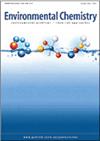牛血清白蛋白与纳米赤铁矿的表面化学性质及其对砷酸盐吸附的影响
IF 2.3
4区 环境科学与生态学
Q3 CHEMISTRY, ANALYTICAL
引用次数: 1
摘要
在环境和生物系统中,红铁矿纳米颗粒是蛋白质和污染物的有效吸附剂。以赤铁矿和牛血清白蛋白(BSA)为模型,研究了其表面化学性质及其在砷酸盐吸附中的竞争作用。结果表明,表面牛血清白蛋白抑制砷酸盐吸附,可能改变其迁移率和生物利用度。摘要金属氧化物纳米材料的表面化学性质控制着其在环境和生物系统中的健康影响和命运。这些系统含有能够与纳米颗粒结合的蛋白质,形成蛋白质冠,改变纳米颗粒的表面特性和对污染物的反应性。利用衰减全反射-傅里叶变换红外(ATR-FTIR)光谱技术,研究了牛血清白蛋白(BSA)在赤铁矿纳米颗粒上的吸附,并量化了BSA对砷酸盐(AsV)吸附动力学的竞争效应。实验在pH为7的流动模式下进行。首先将BSA吸附在赤铁矿上,然后让AsV在BSA/赤铁矿薄膜上流动。采用改进的Langmuir吸附模型计算了BSA和AsV的吸附动力学和热力学参数。吸附热力学模型表明,BSA通过两个活性位点结合,结合能为-41 kJ mol−1,对应于化学吸附和物理吸附两种物质的自发形成。当AsV流过BSA/赤铁矿膜时,只有11%的表面BSA被AsV解吸。这一结果突出了牛血清白蛋白对AsV吸附的抑制作用。BSA的结构分析揭示了赤铁矿纳米颗粒吸附和解吸过程中局部构象几何形状的变化。分子对接模拟表明,模拟的赤铁矿纳米颗粒由于形成各种键,对BSA表面的结合自由能为-6.8 kcal mol - 1 (- 28.5 kJ mol - 1),与吸附动力学模型一致。总的来说,表面牛血清白蛋白抑制砷酸盐吸附,因此增加其流动性和生物利用度。本文章由计算机程序翻译,如有差异,请以英文原文为准。
Surface chemistry of bovine serum albumin with hematite nanoparticles and its effect on arsenate adsorption
Environmental contextHematite nanoparticles are efficient adsorbents for proteins and pollutants in environmental and biological systems. Hematite and the protein bovine serum albumin (BSA) were used as models to investigate the surface chemistry and competitive role of BSA in arsenate adsorption. Results show that surface BSA inhibits arsenate adsorption, potentially altering its mobility and bioavailability.
AbstractThe surface chemistry of metal oxide nanomaterials controls their health impacts and fate in environmental and biological systems. These systems contain proteins capable of binding to nanoparticles, which forms a protein corona that modifies the surface properties of the nanoparticles and reactivity towards pollutants. Using attenuated total reflectance-Fourier transform infrared (ATR-FTIR) spectroscopy, we investigate the adsorption of bovine serum albumin (BSA) and quantify the competitive effect of BSA on the adsorption kinetics of arsenate, AsV, to hematite nanoparticles. Experiments were conducted in the flow mode at pH 7. BSA was first adsorbed on hematite, then AsV was allowed to flow over the BSA/hematite thin film. Adsorption kinetic and thermodynamic parameters were calculated using a modified Langmuir adsorption model for both BSA and AsV. The adsorption thermodynamic model showed that BSA binds through two active sites with a binding energy of –41 kJ mol−1, which corresponds to the spontaneous formation of chemisorbed and physisorbed species. When AsV flowed over the BSA/hematite film, only 11 % of surface BSA was desorbed by AsV. This result highlights the inhibitory effect of BSA for AsV adsorption. Structural analysis of BSA revealed changes to the local conformational geometry upon adsorption to and desorption from hematite nanoparticles. Molecular docking simulations showed that the binding free energy of a modelled hematite nanoparticle towards the BSA surface is –6.8 kcal mol−1 (−28.5 kJ mol−1) owing to the formation of various bonds, which agrees with the adsorption kinetics modelling. Overall, surface BSA inhibits arsenate adsorption and therefore increases its mobility and bioavailability.
求助全文
通过发布文献求助,成功后即可免费获取论文全文。
去求助
来源期刊

Environmental Chemistry
环境科学-分析化学
CiteScore
4.50
自引率
0.00%
发文量
0
审稿时长
2.7 months
期刊介绍:
Environmental Chemistry publishes manuscripts addressing the chemistry of the environment (air, water, earth, and biota), including the behaviour and impacts of contaminants and other anthropogenic disturbances. The scope encompasses atmospheric chemistry, geochemistry and biogeochemistry, climate change, marine and freshwater chemistry, polar chemistry, fire chemistry, soil and sediment chemistry, and chemical aspects of ecotoxicology. Papers that take an interdisciplinary approach, while advancing our understanding of the linkages between chemistry and physical or biological processes, are particularly encouraged.
While focusing on the publication of important original research and timely reviews, the journal also publishes essays and opinion pieces on issues of importance to environmental scientists, such as policy and funding.
Papers should be written in a style that is accessible to those outside the field, as the readership will include - in addition to chemists - biologists, toxicologists, soil scientists, and workers from government and industrial institutions. All manuscripts are rigorously peer-reviewed and professionally copy-edited.
Environmental Chemistry is published with the endorsement of the Commonwealth Scientific and Industrial Research Organisation (CSIRO) and the Australian Academy of Science.
 求助内容:
求助内容: 应助结果提醒方式:
应助结果提醒方式:


